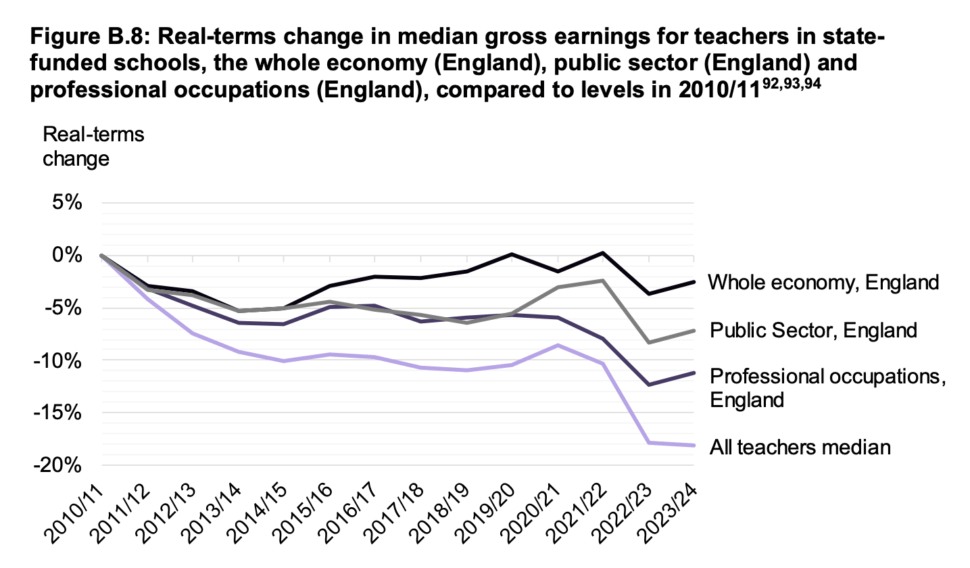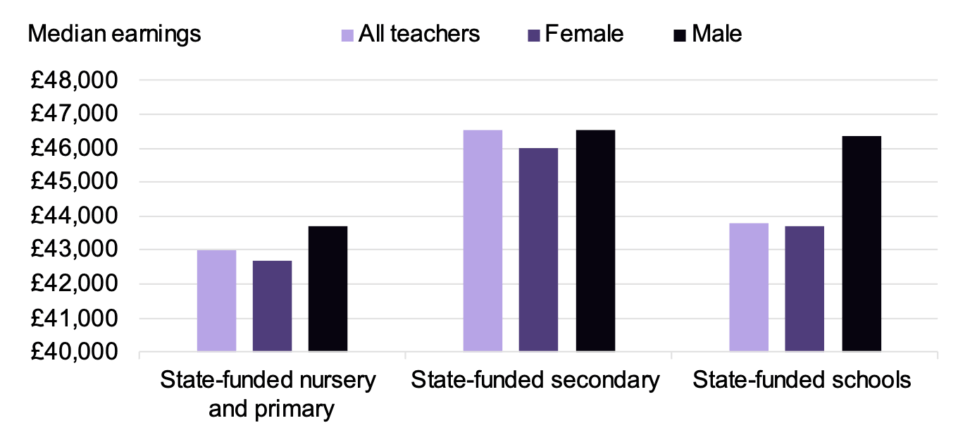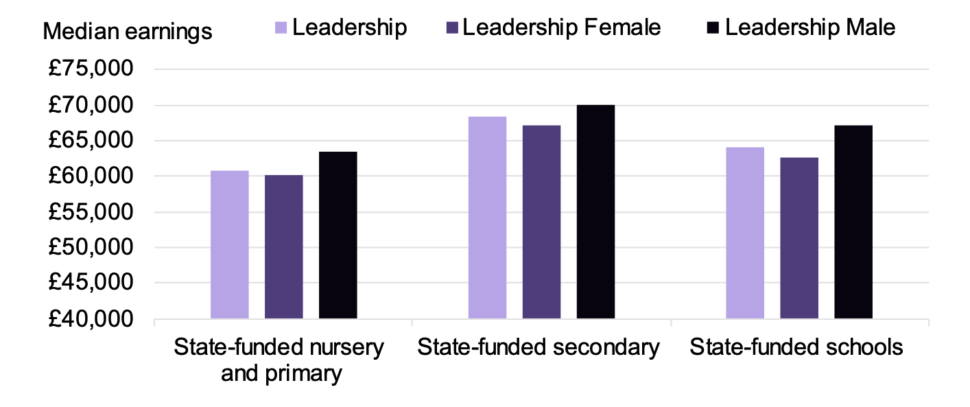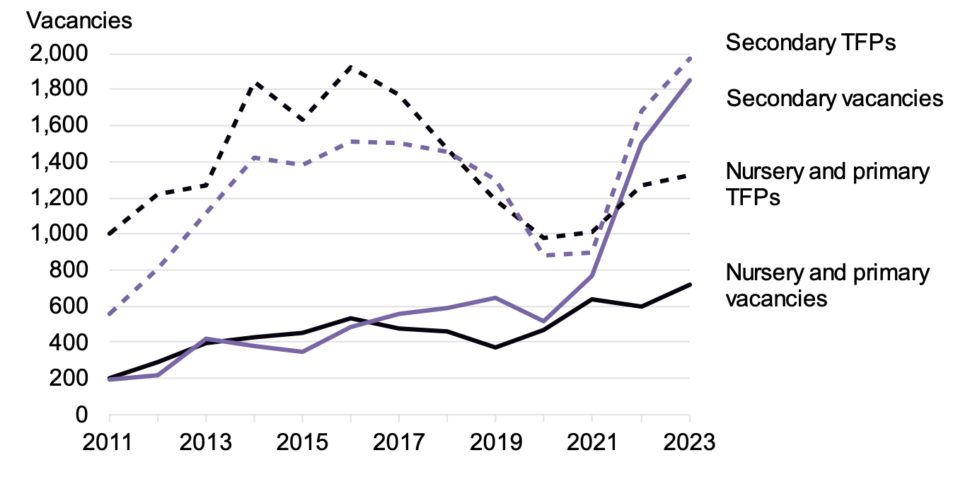Teachers’ pay has been eroded far more sharply than other professions, the rest of the public sector and wages across the economy, new analysis shows.
The School Teachers’ Review Body published its 35th report on Thursday, recommending a 4 per cent pay rise for the 2025-26 academic year. The DfE has accepted its advice, and will provide £615 million in funding, though this will only part-fund the rise.
The body has also suggested some other ways the government could make teaching more competitive.
But the report also includes a lot of useful information and analysis about the teacher workforce itself. Here are five key findings.
1. Teachers’ pay erosion sharper than other professions

The STRB compared teachers’ median earnings to those working in other professional occupations.
Teacher pay fell in real terms throughout the early 2010s. It improved slightly between 2018 and 2021, due to above-inflation rises prior to the pay pause in 2021-22, but then declined again.
The StRB estimated teachers’ earnings in 2023-24 were 18.2 per cent below their level in 2010-11 in real terms. This figure does not take account of last year’s 5.5 per cent pay rise.
Median gross earnings for the whole-economy were 2.5 per cent lower than their 2010-11 level, while for other professional occupations median gross earnings were 11.2 per cent lower, in real terms.
2. Leadership gender pay gap widens
Women make up the majority of classroom teachers – 86 per cent in primary schools and 65 of secondary schools.
However, men accounted for 22 per cent of leadership roles in primary.

In secondary, men made up 37 per cent of the total workforce, but 46 per cent of leadership roles. This remains in line with the previous year.
Median earnings for male classroom teachers were 2.6 per cent higher than female teachers.

The gender pay gap in leadership has also widened slightly since 2022-23.
Male leadership teachers have higher median earnings across both phases: +5.3 per cent for nursery and primary and +4.2 per cent for secondary. This compares to +4.9 per cent and +3.8 per cent respectively for 2021-22.
3. Pupil-to-teacher ratios largely unchanged
The overall pupil-to-teacher ratio (PTR) peaked in 2019-20 but “remains high relative to pre-2018”, says the STRB.
This is underpinned by increasing secondary school pupil numbers which are projected to rise until 2027 due to a population bulge currently making its way through the school system.
This increase in pupils has been offset by an increase in teachers in recent years, with the total full-time equivalent teacher workforce now at its highest level since 2010-11.
For secondary schools, the PTR for qualified teachers was 17.4 in 2023-24, a slight increase from a relatively stable period from 2019 to 2023 (17.1 to 17.2).
The average secondary class size was 22.4 in 2023-24. It has been stable over the past four years but remains higher than before 2020-21.
4. Temporary filled posts hit record high
The report also shines a light on teacher vacancies.
In November 2023, according to school workforce census (SWC) data, the teacher vacancy rate across all state-funded schools was 0.6 per cent, higher than the previous year (0.5 per cent) and the highest since current records began in 2010.
The vacancy rate for classroom teachers was 0.6 per cent, whilst for leaders it was 0.3 per cent.
In absolute terms, the number of vacancies across state-funded schools increased by 468 compared to the previous year, reaching 2,802.

Temporarily filled posts (TFPs) are those where a vacancy is being filled by a teacher on a contract of at least one term, but less than a year.
There were 3,655 TFPs in 2023. After peaking in 2016-17 at 3,795, the number of TFPs fell but has risen in the last two years to almost record highs.
5. Rise in trainee teachers
The STRB report shows there were 27,746 new entrants to initial teacher training (ITT) in 2024-25 – 5 per cent more than the 26,342 who entered the previous year.
Of these, there were 23,011 new entrants to postgraduate ITT, an increase of 8 per cent from the previous year.
The DfE recently announced it is lowering its PGITT recruitment targets for the coming academic year, in light of a rise in recruitment and forecast boost to retention, following recent pay awards.
Meanwhile there were 4,735 new entrants to undergraduate ITT – a decrease of five per cent.
The number of candidates applying to primary ITT courses has remained steady from 2023-24 to 2024-25, while the number of accepted candidates decreased by 4 per cent to 8,949.
For secondary subjects, the number of candidates applying for 2024-25 courses increased by 25 per cent compared to the previous year, while the number of accepted candidates increased by 16 per cent.








Your thoughts